Diabetes Complications and Management
VerifiedAdded on 2020/01/16
|15
|4955
|181
AI Summary
This assignment delves into the complexities of diabetes complications, encompassing both microvascular and macrovascular aspects. It analyzes the underlying mechanisms responsible for these complications, highlighting the crucial role of insulin resistance and lipotoxicity. The assignment further explores the diverse clinical manifestations of diabetic complications, ranging from retinopathy and nephropathy to cardiovascular disease and peripheral neuropathy. Finally, it discusses effective management strategies aimed at mitigating the development and progression of these debilitating consequences.
Contribute Materials
Your contribution can guide someone’s learning journey. Share your
documents today.

Running head: ASSESSMENT TASK 2 - DIABETES PATHOPHYSIOLOGY 1
Assessment Task 2 - Diabetes Pathophysiology
Student's Name:
Student's Number:
Word Count:
Assessment Task 2 - Diabetes Pathophysiology
Student's Name:
Student's Number:
Word Count:
Secure Best Marks with AI Grader
Need help grading? Try our AI Grader for instant feedback on your assignments.
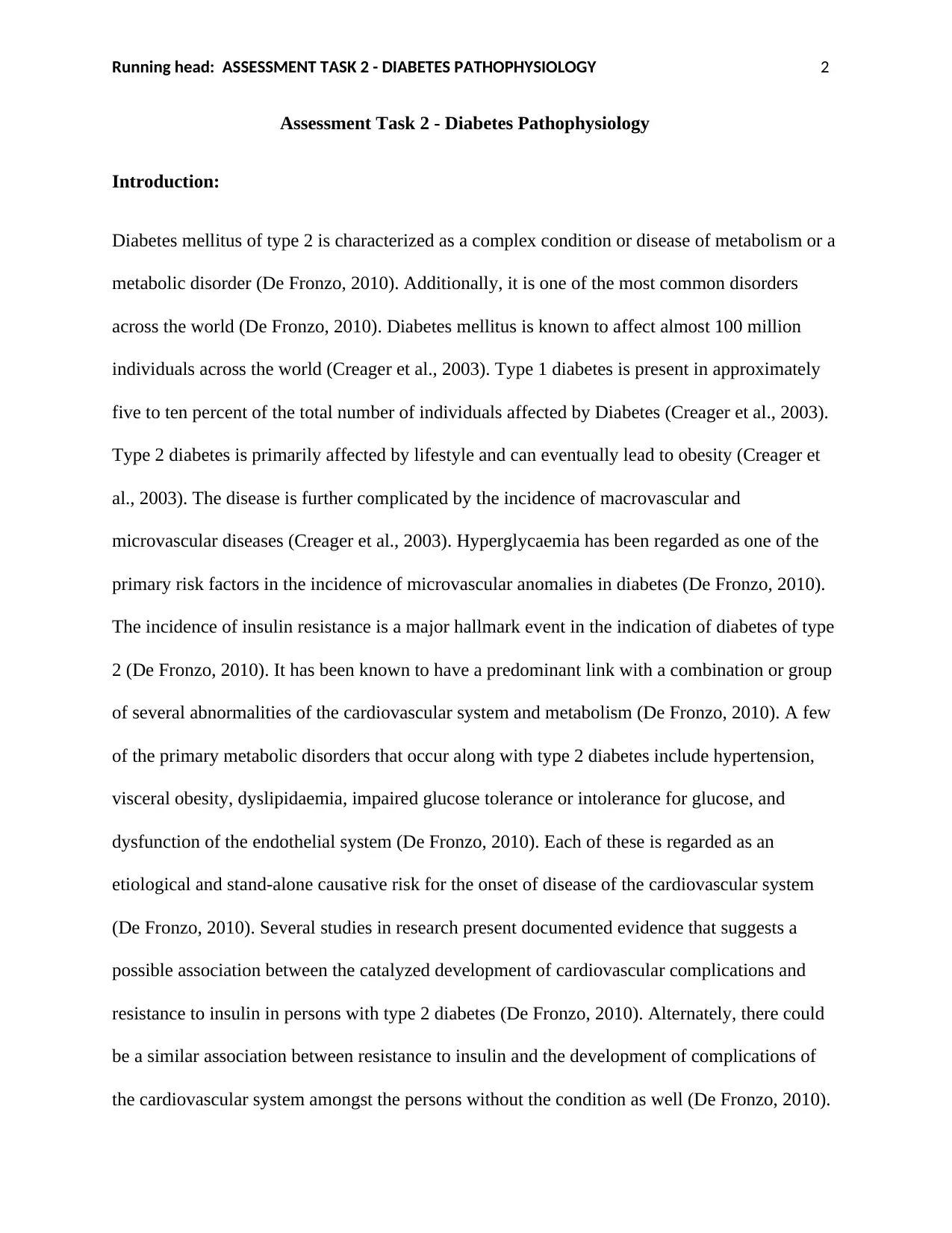
Running head: ASSESSMENT TASK 2 - DIABETES PATHOPHYSIOLOGY 2
Assessment Task 2 - Diabetes Pathophysiology
Introduction:
Diabetes mellitus of type 2 is characterized as a complex condition or disease of metabolism or a
metabolic disorder (De Fronzo, 2010). Additionally, it is one of the most common disorders
across the world (De Fronzo, 2010). Diabetes mellitus is known to affect almost 100 million
individuals across the world (Creager et al., 2003). Type 1 diabetes is present in approximately
five to ten percent of the total number of individuals affected by Diabetes (Creager et al., 2003).
Type 2 diabetes is primarily affected by lifestyle and can eventually lead to obesity (Creager et
al., 2003). The disease is further complicated by the incidence of macrovascular and
microvascular diseases (Creager et al., 2003). Hyperglycaemia has been regarded as one of the
primary risk factors in the incidence of microvascular anomalies in diabetes (De Fronzo, 2010).
The incidence of insulin resistance is a major hallmark event in the indication of diabetes of type
2 (De Fronzo, 2010). It has been known to have a predominant link with a combination or group
of several abnormalities of the cardiovascular system and metabolism (De Fronzo, 2010). A few
of the primary metabolic disorders that occur along with type 2 diabetes include hypertension,
visceral obesity, dyslipidaemia, impaired glucose tolerance or intolerance for glucose, and
dysfunction of the endothelial system (De Fronzo, 2010). Each of these is regarded as an
etiological and stand-alone causative risk for the onset of disease of the cardiovascular system
(De Fronzo, 2010). Several studies in research present documented evidence that suggests a
possible association between the catalyzed development of cardiovascular complications and
resistance to insulin in persons with type 2 diabetes (De Fronzo, 2010). Alternately, there could
be a similar association between resistance to insulin and the development of complications of
the cardiovascular system amongst the persons without the condition as well (De Fronzo, 2010).
Assessment Task 2 - Diabetes Pathophysiology
Introduction:
Diabetes mellitus of type 2 is characterized as a complex condition or disease of metabolism or a
metabolic disorder (De Fronzo, 2010). Additionally, it is one of the most common disorders
across the world (De Fronzo, 2010). Diabetes mellitus is known to affect almost 100 million
individuals across the world (Creager et al., 2003). Type 1 diabetes is present in approximately
five to ten percent of the total number of individuals affected by Diabetes (Creager et al., 2003).
Type 2 diabetes is primarily affected by lifestyle and can eventually lead to obesity (Creager et
al., 2003). The disease is further complicated by the incidence of macrovascular and
microvascular diseases (Creager et al., 2003). Hyperglycaemia has been regarded as one of the
primary risk factors in the incidence of microvascular anomalies in diabetes (De Fronzo, 2010).
The incidence of insulin resistance is a major hallmark event in the indication of diabetes of type
2 (De Fronzo, 2010). It has been known to have a predominant link with a combination or group
of several abnormalities of the cardiovascular system and metabolism (De Fronzo, 2010). A few
of the primary metabolic disorders that occur along with type 2 diabetes include hypertension,
visceral obesity, dyslipidaemia, impaired glucose tolerance or intolerance for glucose, and
dysfunction of the endothelial system (De Fronzo, 2010). Each of these is regarded as an
etiological and stand-alone causative risk for the onset of disease of the cardiovascular system
(De Fronzo, 2010). Several studies in research present documented evidence that suggests a
possible association between the catalyzed development of cardiovascular complications and
resistance to insulin in persons with type 2 diabetes (De Fronzo, 2010). Alternately, there could
be a similar association between resistance to insulin and the development of complications of
the cardiovascular system amongst the persons without the condition as well (De Fronzo, 2010).
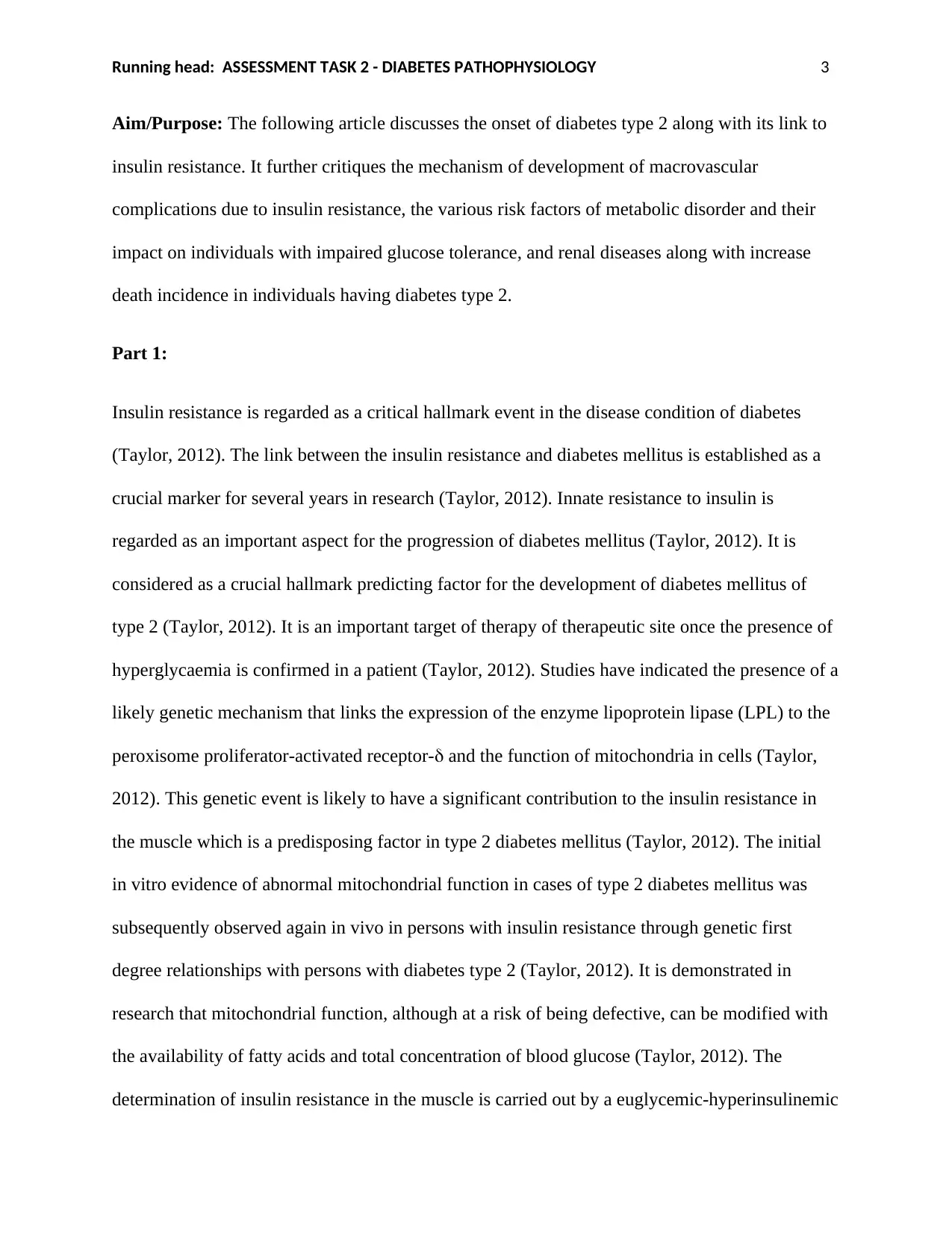
Running head: ASSESSMENT TASK 2 - DIABETES PATHOPHYSIOLOGY 3
Aim/Purpose: The following article discusses the onset of diabetes type 2 along with its link to
insulin resistance. It further critiques the mechanism of development of macrovascular
complications due to insulin resistance, the various risk factors of metabolic disorder and their
impact on individuals with impaired glucose tolerance, and renal diseases along with increase
death incidence in individuals having diabetes type 2.
Part 1:
Insulin resistance is regarded as a critical hallmark event in the disease condition of diabetes
(Taylor, 2012). The link between the insulin resistance and diabetes mellitus is established as a
crucial marker for several years in research (Taylor, 2012). Innate resistance to insulin is
regarded as an important aspect for the progression of diabetes mellitus (Taylor, 2012). It is
considered as a crucial hallmark predicting factor for the development of diabetes mellitus of
type 2 (Taylor, 2012). It is an important target of therapy of therapeutic site once the presence of
hyperglycaemia is confirmed in a patient (Taylor, 2012). Studies have indicated the presence of a
likely genetic mechanism that links the expression of the enzyme lipoprotein lipase (LPL) to the
peroxisome proliferator-activated receptor- and the function of mitochondria in cells (Taylor,
2012). This genetic event is likely to have a significant contribution to the insulin resistance in
the muscle which is a predisposing factor in type 2 diabetes mellitus (Taylor, 2012). The initial
in vitro evidence of abnormal mitochondrial function in cases of type 2 diabetes mellitus was
subsequently observed again in vivo in persons with insulin resistance through genetic first
degree relationships with persons with diabetes type 2 (Taylor, 2012). It is demonstrated in
research that mitochondrial function, although at a risk of being defective, can be modified with
the availability of fatty acids and total concentration of blood glucose (Taylor, 2012). The
determination of insulin resistance in the muscle is carried out by a euglycemic-hyperinsulinemic
Aim/Purpose: The following article discusses the onset of diabetes type 2 along with its link to
insulin resistance. It further critiques the mechanism of development of macrovascular
complications due to insulin resistance, the various risk factors of metabolic disorder and their
impact on individuals with impaired glucose tolerance, and renal diseases along with increase
death incidence in individuals having diabetes type 2.
Part 1:
Insulin resistance is regarded as a critical hallmark event in the disease condition of diabetes
(Taylor, 2012). The link between the insulin resistance and diabetes mellitus is established as a
crucial marker for several years in research (Taylor, 2012). Innate resistance to insulin is
regarded as an important aspect for the progression of diabetes mellitus (Taylor, 2012). It is
considered as a crucial hallmark predicting factor for the development of diabetes mellitus of
type 2 (Taylor, 2012). It is an important target of therapy of therapeutic site once the presence of
hyperglycaemia is confirmed in a patient (Taylor, 2012). Studies have indicated the presence of a
likely genetic mechanism that links the expression of the enzyme lipoprotein lipase (LPL) to the
peroxisome proliferator-activated receptor- and the function of mitochondria in cells (Taylor,
2012). This genetic event is likely to have a significant contribution to the insulin resistance in
the muscle which is a predisposing factor in type 2 diabetes mellitus (Taylor, 2012). The initial
in vitro evidence of abnormal mitochondrial function in cases of type 2 diabetes mellitus was
subsequently observed again in vivo in persons with insulin resistance through genetic first
degree relationships with persons with diabetes type 2 (Taylor, 2012). It is demonstrated in
research that mitochondrial function, although at a risk of being defective, can be modified with
the availability of fatty acids and total concentration of blood glucose (Taylor, 2012). The
determination of insulin resistance in the muscle is carried out by a euglycemic-hyperinsulinemic
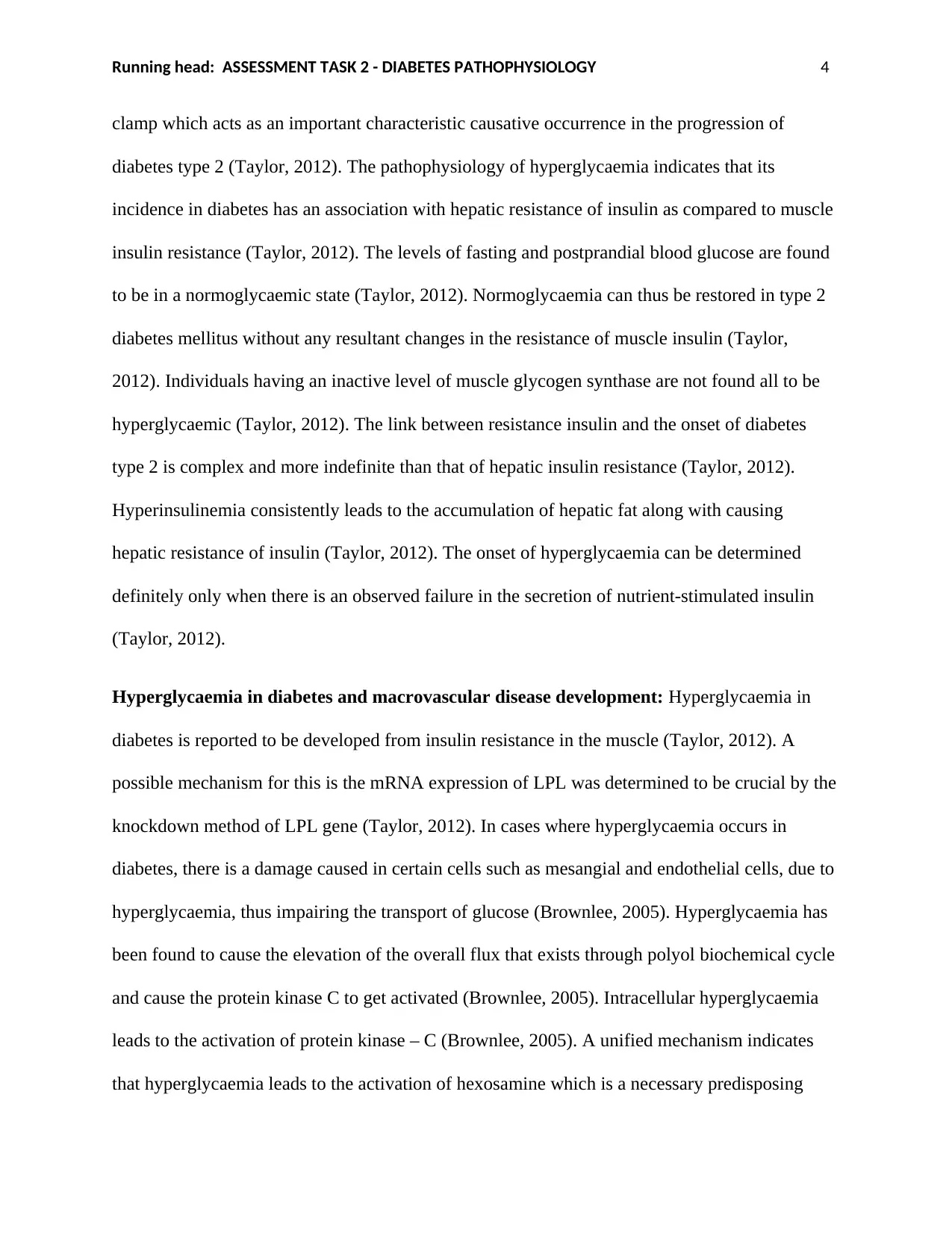
Running head: ASSESSMENT TASK 2 - DIABETES PATHOPHYSIOLOGY 4
clamp which acts as an important characteristic causative occurrence in the progression of
diabetes type 2 (Taylor, 2012). The pathophysiology of hyperglycaemia indicates that its
incidence in diabetes has an association with hepatic resistance of insulin as compared to muscle
insulin resistance (Taylor, 2012). The levels of fasting and postprandial blood glucose are found
to be in a normoglycaemic state (Taylor, 2012). Normoglycaemia can thus be restored in type 2
diabetes mellitus without any resultant changes in the resistance of muscle insulin (Taylor,
2012). Individuals having an inactive level of muscle glycogen synthase are not found all to be
hyperglycaemic (Taylor, 2012). The link between resistance insulin and the onset of diabetes
type 2 is complex and more indefinite than that of hepatic insulin resistance (Taylor, 2012).
Hyperinsulinemia consistently leads to the accumulation of hepatic fat along with causing
hepatic resistance of insulin (Taylor, 2012). The onset of hyperglycaemia can be determined
definitely only when there is an observed failure in the secretion of nutrient-stimulated insulin
(Taylor, 2012).
Hyperglycaemia in diabetes and macrovascular disease development: Hyperglycaemia in
diabetes is reported to be developed from insulin resistance in the muscle (Taylor, 2012). A
possible mechanism for this is the mRNA expression of LPL was determined to be crucial by the
knockdown method of LPL gene (Taylor, 2012). In cases where hyperglycaemia occurs in
diabetes, there is a damage caused in certain cells such as mesangial and endothelial cells, due to
hyperglycaemia, thus impairing the transport of glucose (Brownlee, 2005). Hyperglycaemia has
been found to cause the elevation of the overall flux that exists through polyol biochemical cycle
and cause the protein kinase C to get activated (Brownlee, 2005). Intracellular hyperglycaemia
leads to the activation of protein kinase – C (Brownlee, 2005). A unified mechanism indicates
that hyperglycaemia leads to the activation of hexosamine which is a necessary predisposing
clamp which acts as an important characteristic causative occurrence in the progression of
diabetes type 2 (Taylor, 2012). The pathophysiology of hyperglycaemia indicates that its
incidence in diabetes has an association with hepatic resistance of insulin as compared to muscle
insulin resistance (Taylor, 2012). The levels of fasting and postprandial blood glucose are found
to be in a normoglycaemic state (Taylor, 2012). Normoglycaemia can thus be restored in type 2
diabetes mellitus without any resultant changes in the resistance of muscle insulin (Taylor,
2012). Individuals having an inactive level of muscle glycogen synthase are not found all to be
hyperglycaemic (Taylor, 2012). The link between resistance insulin and the onset of diabetes
type 2 is complex and more indefinite than that of hepatic insulin resistance (Taylor, 2012).
Hyperinsulinemia consistently leads to the accumulation of hepatic fat along with causing
hepatic resistance of insulin (Taylor, 2012). The onset of hyperglycaemia can be determined
definitely only when there is an observed failure in the secretion of nutrient-stimulated insulin
(Taylor, 2012).
Hyperglycaemia in diabetes and macrovascular disease development: Hyperglycaemia in
diabetes is reported to be developed from insulin resistance in the muscle (Taylor, 2012). A
possible mechanism for this is the mRNA expression of LPL was determined to be crucial by the
knockdown method of LPL gene (Taylor, 2012). In cases where hyperglycaemia occurs in
diabetes, there is a damage caused in certain cells such as mesangial and endothelial cells, due to
hyperglycaemia, thus impairing the transport of glucose (Brownlee, 2005). Hyperglycaemia has
been found to cause the elevation of the overall flux that exists through polyol biochemical cycle
and cause the protein kinase C to get activated (Brownlee, 2005). Intracellular hyperglycaemia
leads to the activation of protein kinase – C (Brownlee, 2005). A unified mechanism indicates
that hyperglycaemia leads to the activation of hexosamine which is a necessary predisposing
Secure Best Marks with AI Grader
Need help grading? Try our AI Grader for instant feedback on your assignments.
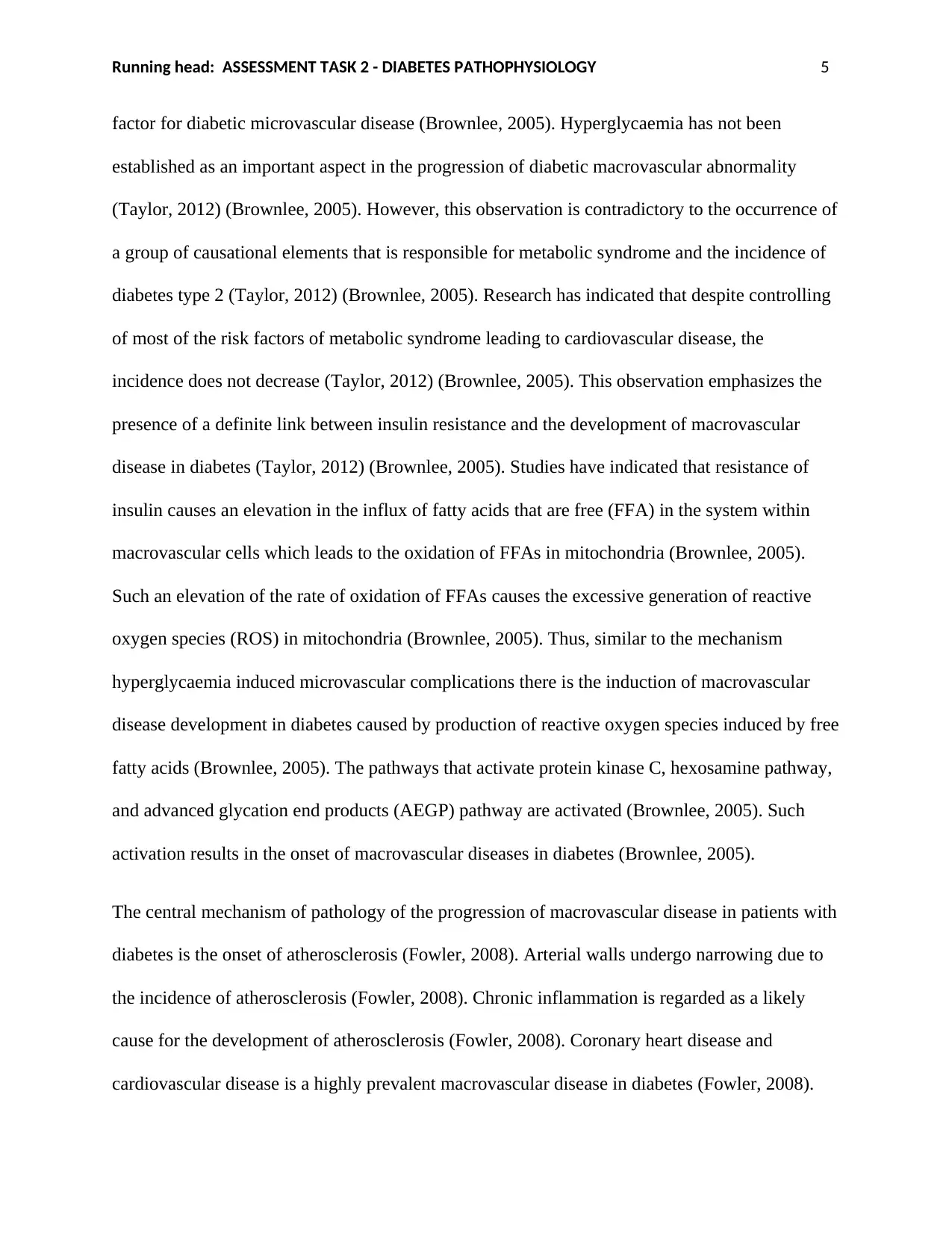
Running head: ASSESSMENT TASK 2 - DIABETES PATHOPHYSIOLOGY 5
factor for diabetic microvascular disease (Brownlee, 2005). Hyperglycaemia has not been
established as an important aspect in the progression of diabetic macrovascular abnormality
(Taylor, 2012) (Brownlee, 2005). However, this observation is contradictory to the occurrence of
a group of causational elements that is responsible for metabolic syndrome and the incidence of
diabetes type 2 (Taylor, 2012) (Brownlee, 2005). Research has indicated that despite controlling
of most of the risk factors of metabolic syndrome leading to cardiovascular disease, the
incidence does not decrease (Taylor, 2012) (Brownlee, 2005). This observation emphasizes the
presence of a definite link between insulin resistance and the development of macrovascular
disease in diabetes (Taylor, 2012) (Brownlee, 2005). Studies have indicated that resistance of
insulin causes an elevation in the influx of fatty acids that are free (FFA) in the system within
macrovascular cells which leads to the oxidation of FFAs in mitochondria (Brownlee, 2005).
Such an elevation of the rate of oxidation of FFAs causes the excessive generation of reactive
oxygen species (ROS) in mitochondria (Brownlee, 2005). Thus, similar to the mechanism
hyperglycaemia induced microvascular complications there is the induction of macrovascular
disease development in diabetes caused by production of reactive oxygen species induced by free
fatty acids (Brownlee, 2005). The pathways that activate protein kinase C, hexosamine pathway,
and advanced glycation end products (AEGP) pathway are activated (Brownlee, 2005). Such
activation results in the onset of macrovascular diseases in diabetes (Brownlee, 2005).
The central mechanism of pathology of the progression of macrovascular disease in patients with
diabetes is the onset of atherosclerosis (Fowler, 2008). Arterial walls undergo narrowing due to
the incidence of atherosclerosis (Fowler, 2008). Chronic inflammation is regarded as a likely
cause for the development of atherosclerosis (Fowler, 2008). Coronary heart disease and
cardiovascular disease is a highly prevalent macrovascular disease in diabetes (Fowler, 2008).
factor for diabetic microvascular disease (Brownlee, 2005). Hyperglycaemia has not been
established as an important aspect in the progression of diabetic macrovascular abnormality
(Taylor, 2012) (Brownlee, 2005). However, this observation is contradictory to the occurrence of
a group of causational elements that is responsible for metabolic syndrome and the incidence of
diabetes type 2 (Taylor, 2012) (Brownlee, 2005). Research has indicated that despite controlling
of most of the risk factors of metabolic syndrome leading to cardiovascular disease, the
incidence does not decrease (Taylor, 2012) (Brownlee, 2005). This observation emphasizes the
presence of a definite link between insulin resistance and the development of macrovascular
disease in diabetes (Taylor, 2012) (Brownlee, 2005). Studies have indicated that resistance of
insulin causes an elevation in the influx of fatty acids that are free (FFA) in the system within
macrovascular cells which leads to the oxidation of FFAs in mitochondria (Brownlee, 2005).
Such an elevation of the rate of oxidation of FFAs causes the excessive generation of reactive
oxygen species (ROS) in mitochondria (Brownlee, 2005). Thus, similar to the mechanism
hyperglycaemia induced microvascular complications there is the induction of macrovascular
disease development in diabetes caused by production of reactive oxygen species induced by free
fatty acids (Brownlee, 2005). The pathways that activate protein kinase C, hexosamine pathway,
and advanced glycation end products (AEGP) pathway are activated (Brownlee, 2005). Such
activation results in the onset of macrovascular diseases in diabetes (Brownlee, 2005).
The central mechanism of pathology of the progression of macrovascular disease in patients with
diabetes is the onset of atherosclerosis (Fowler, 2008). Arterial walls undergo narrowing due to
the incidence of atherosclerosis (Fowler, 2008). Chronic inflammation is regarded as a likely
cause for the development of atherosclerosis (Fowler, 2008). Coronary heart disease and
cardiovascular disease is a highly prevalent macrovascular disease in diabetes (Fowler, 2008).
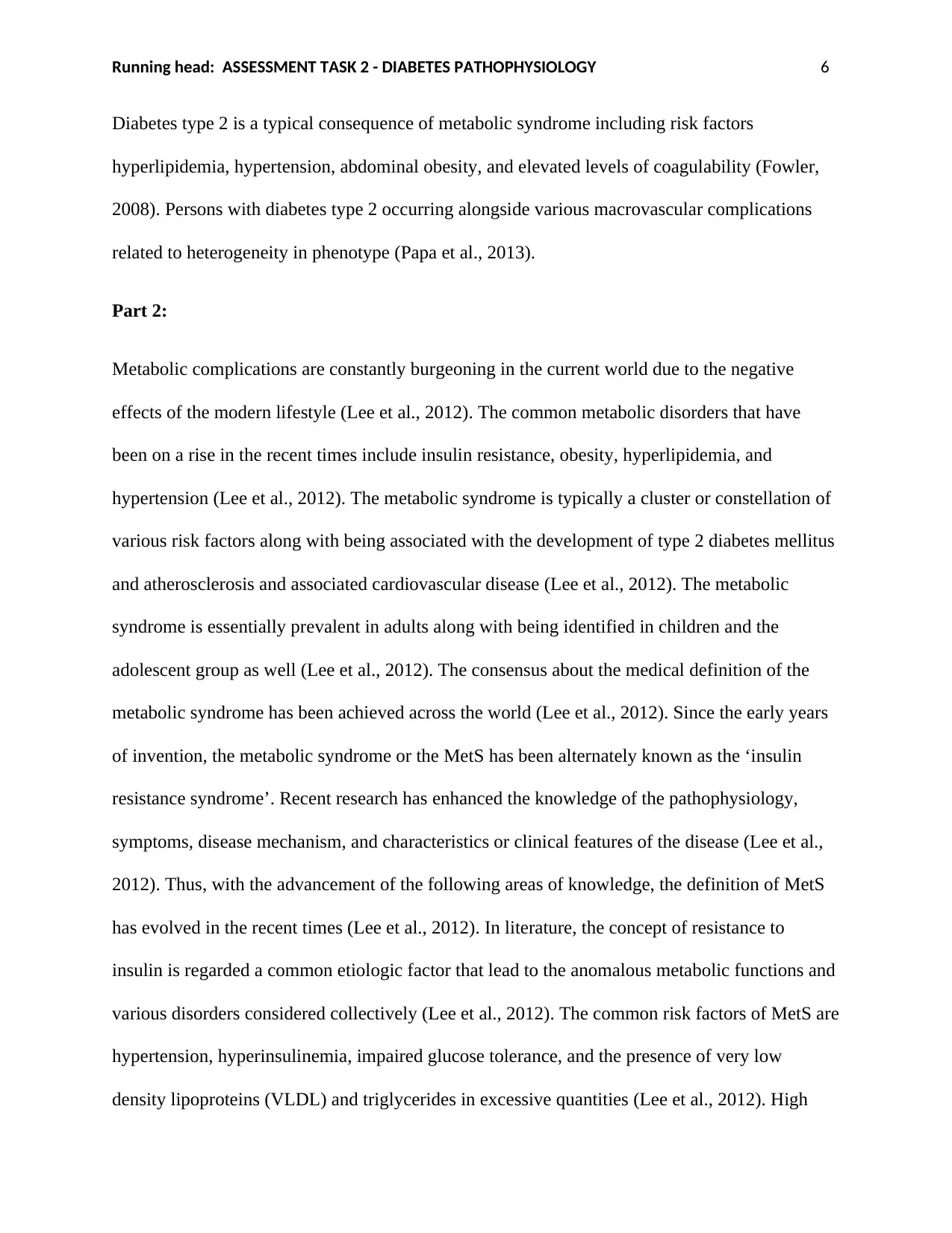
Running head: ASSESSMENT TASK 2 - DIABETES PATHOPHYSIOLOGY 6
Diabetes type 2 is a typical consequence of metabolic syndrome including risk factors
hyperlipidemia, hypertension, abdominal obesity, and elevated levels of coagulability (Fowler,
2008). Persons with diabetes type 2 occurring alongside various macrovascular complications
related to heterogeneity in phenotype (Papa et al., 2013).
Part 2:
Metabolic complications are constantly burgeoning in the current world due to the negative
effects of the modern lifestyle (Lee et al., 2012). The common metabolic disorders that have
been on a rise in the recent times include insulin resistance, obesity, hyperlipidemia, and
hypertension (Lee et al., 2012). The metabolic syndrome is typically a cluster or constellation of
various risk factors along with being associated with the development of type 2 diabetes mellitus
and atherosclerosis and associated cardiovascular disease (Lee et al., 2012). The metabolic
syndrome is essentially prevalent in adults along with being identified in children and the
adolescent group as well (Lee et al., 2012). The consensus about the medical definition of the
metabolic syndrome has been achieved across the world (Lee et al., 2012). Since the early years
of invention, the metabolic syndrome or the MetS has been alternately known as the ‘insulin
resistance syndrome’. Recent research has enhanced the knowledge of the pathophysiology,
symptoms, disease mechanism, and characteristics or clinical features of the disease (Lee et al.,
2012). Thus, with the advancement of the following areas of knowledge, the definition of MetS
has evolved in the recent times (Lee et al., 2012). In literature, the concept of resistance to
insulin is regarded a common etiologic factor that lead to the anomalous metabolic functions and
various disorders considered collectively (Lee et al., 2012). The common risk factors of MetS are
hypertension, hyperinsulinemia, impaired glucose tolerance, and the presence of very low
density lipoproteins (VLDL) and triglycerides in excessive quantities (Lee et al., 2012). High
Diabetes type 2 is a typical consequence of metabolic syndrome including risk factors
hyperlipidemia, hypertension, abdominal obesity, and elevated levels of coagulability (Fowler,
2008). Persons with diabetes type 2 occurring alongside various macrovascular complications
related to heterogeneity in phenotype (Papa et al., 2013).
Part 2:
Metabolic complications are constantly burgeoning in the current world due to the negative
effects of the modern lifestyle (Lee et al., 2012). The common metabolic disorders that have
been on a rise in the recent times include insulin resistance, obesity, hyperlipidemia, and
hypertension (Lee et al., 2012). The metabolic syndrome is typically a cluster or constellation of
various risk factors along with being associated with the development of type 2 diabetes mellitus
and atherosclerosis and associated cardiovascular disease (Lee et al., 2012). The metabolic
syndrome is essentially prevalent in adults along with being identified in children and the
adolescent group as well (Lee et al., 2012). The consensus about the medical definition of the
metabolic syndrome has been achieved across the world (Lee et al., 2012). Since the early years
of invention, the metabolic syndrome or the MetS has been alternately known as the ‘insulin
resistance syndrome’. Recent research has enhanced the knowledge of the pathophysiology,
symptoms, disease mechanism, and characteristics or clinical features of the disease (Lee et al.,
2012). Thus, with the advancement of the following areas of knowledge, the definition of MetS
has evolved in the recent times (Lee et al., 2012). In literature, the concept of resistance to
insulin is regarded a common etiologic factor that lead to the anomalous metabolic functions and
various disorders considered collectively (Lee et al., 2012). The common risk factors of MetS are
hypertension, hyperinsulinemia, impaired glucose tolerance, and the presence of very low
density lipoproteins (VLDL) and triglycerides in excessive quantities (Lee et al., 2012). High
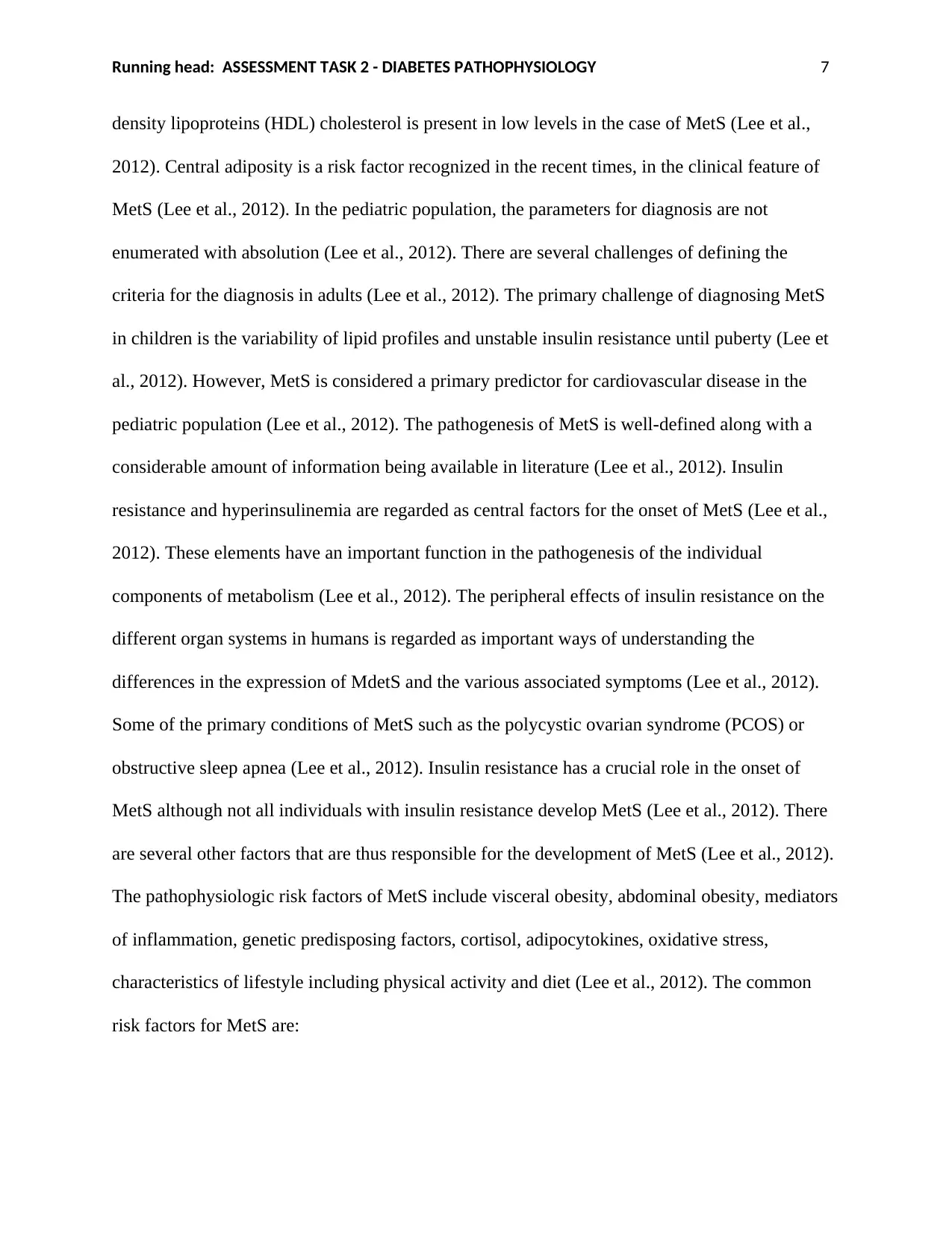
Running head: ASSESSMENT TASK 2 - DIABETES PATHOPHYSIOLOGY 7
density lipoproteins (HDL) cholesterol is present in low levels in the case of MetS (Lee et al.,
2012). Central adiposity is a risk factor recognized in the recent times, in the clinical feature of
MetS (Lee et al., 2012). In the pediatric population, the parameters for diagnosis are not
enumerated with absolution (Lee et al., 2012). There are several challenges of defining the
criteria for the diagnosis in adults (Lee et al., 2012). The primary challenge of diagnosing MetS
in children is the variability of lipid profiles and unstable insulin resistance until puberty (Lee et
al., 2012). However, MetS is considered a primary predictor for cardiovascular disease in the
pediatric population (Lee et al., 2012). The pathogenesis of MetS is well-defined along with a
considerable amount of information being available in literature (Lee et al., 2012). Insulin
resistance and hyperinsulinemia are regarded as central factors for the onset of MetS (Lee et al.,
2012). These elements have an important function in the pathogenesis of the individual
components of metabolism (Lee et al., 2012). The peripheral effects of insulin resistance on the
different organ systems in humans is regarded as important ways of understanding the
differences in the expression of MdetS and the various associated symptoms (Lee et al., 2012).
Some of the primary conditions of MetS such as the polycystic ovarian syndrome (PCOS) or
obstructive sleep apnea (Lee et al., 2012). Insulin resistance has a crucial role in the onset of
MetS although not all individuals with insulin resistance develop MetS (Lee et al., 2012). There
are several other factors that are thus responsible for the development of MetS (Lee et al., 2012).
The pathophysiologic risk factors of MetS include visceral obesity, abdominal obesity, mediators
of inflammation, genetic predisposing factors, cortisol, adipocytokines, oxidative stress,
characteristics of lifestyle including physical activity and diet (Lee et al., 2012). The common
risk factors for MetS are:
density lipoproteins (HDL) cholesterol is present in low levels in the case of MetS (Lee et al.,
2012). Central adiposity is a risk factor recognized in the recent times, in the clinical feature of
MetS (Lee et al., 2012). In the pediatric population, the parameters for diagnosis are not
enumerated with absolution (Lee et al., 2012). There are several challenges of defining the
criteria for the diagnosis in adults (Lee et al., 2012). The primary challenge of diagnosing MetS
in children is the variability of lipid profiles and unstable insulin resistance until puberty (Lee et
al., 2012). However, MetS is considered a primary predictor for cardiovascular disease in the
pediatric population (Lee et al., 2012). The pathogenesis of MetS is well-defined along with a
considerable amount of information being available in literature (Lee et al., 2012). Insulin
resistance and hyperinsulinemia are regarded as central factors for the onset of MetS (Lee et al.,
2012). These elements have an important function in the pathogenesis of the individual
components of metabolism (Lee et al., 2012). The peripheral effects of insulin resistance on the
different organ systems in humans is regarded as important ways of understanding the
differences in the expression of MdetS and the various associated symptoms (Lee et al., 2012).
Some of the primary conditions of MetS such as the polycystic ovarian syndrome (PCOS) or
obstructive sleep apnea (Lee et al., 2012). Insulin resistance has a crucial role in the onset of
MetS although not all individuals with insulin resistance develop MetS (Lee et al., 2012). There
are several other factors that are thus responsible for the development of MetS (Lee et al., 2012).
The pathophysiologic risk factors of MetS include visceral obesity, abdominal obesity, mediators
of inflammation, genetic predisposing factors, cortisol, adipocytokines, oxidative stress,
characteristics of lifestyle including physical activity and diet (Lee et al., 2012). The common
risk factors for MetS are:
Paraphrase This Document
Need a fresh take? Get an instant paraphrase of this document with our AI Paraphraser
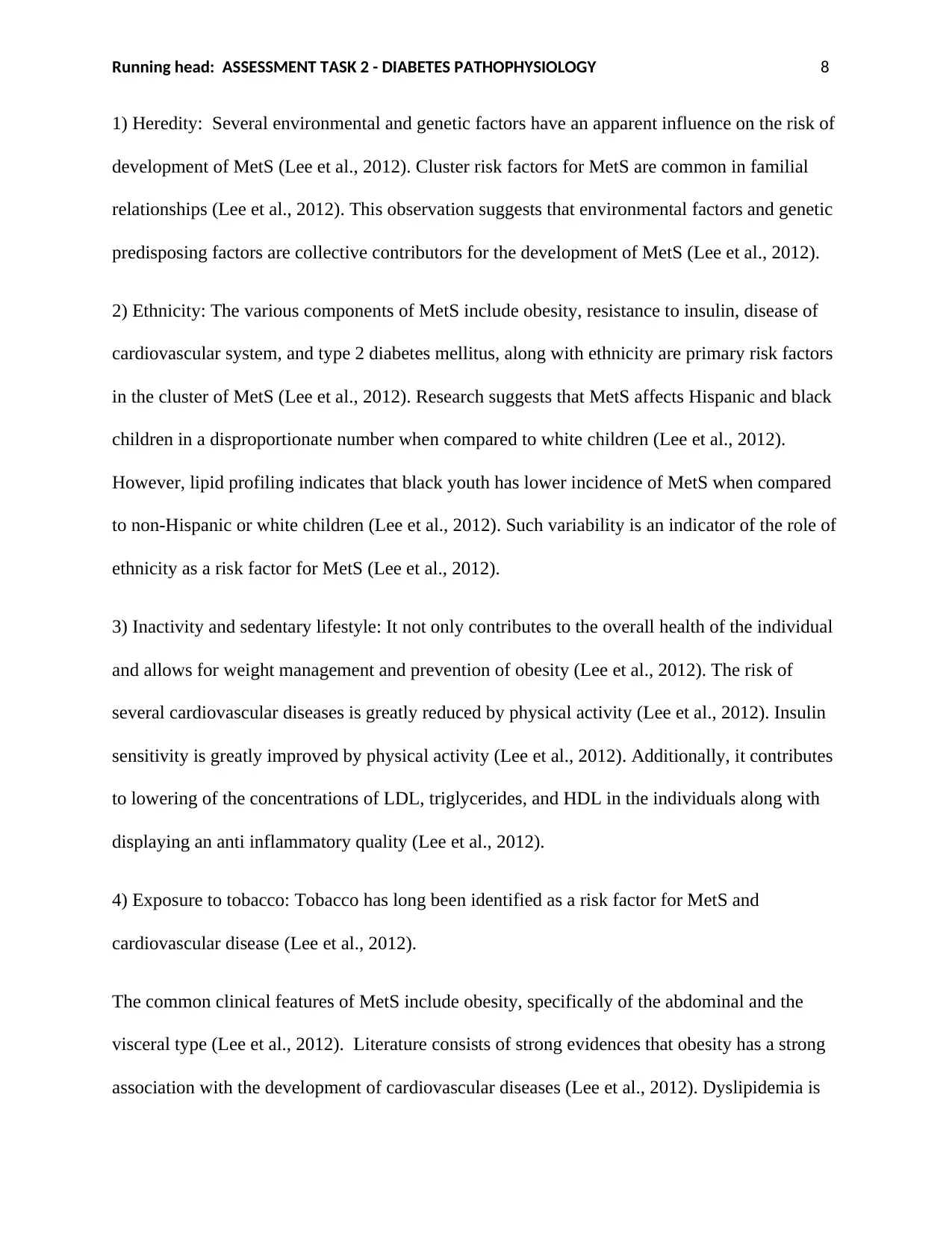
Running head: ASSESSMENT TASK 2 - DIABETES PATHOPHYSIOLOGY 8
1) Heredity: Several environmental and genetic factors have an apparent influence on the risk of
development of MetS (Lee et al., 2012). Cluster risk factors for MetS are common in familial
relationships (Lee et al., 2012). This observation suggests that environmental factors and genetic
predisposing factors are collective contributors for the development of MetS (Lee et al., 2012).
2) Ethnicity: The various components of MetS include obesity, resistance to insulin, disease of
cardiovascular system, and type 2 diabetes mellitus, along with ethnicity are primary risk factors
in the cluster of MetS (Lee et al., 2012). Research suggests that MetS affects Hispanic and black
children in a disproportionate number when compared to white children (Lee et al., 2012).
However, lipid profiling indicates that black youth has lower incidence of MetS when compared
to non-Hispanic or white children (Lee et al., 2012). Such variability is an indicator of the role of
ethnicity as a risk factor for MetS (Lee et al., 2012).
3) Inactivity and sedentary lifestyle: It not only contributes to the overall health of the individual
and allows for weight management and prevention of obesity (Lee et al., 2012). The risk of
several cardiovascular diseases is greatly reduced by physical activity (Lee et al., 2012). Insulin
sensitivity is greatly improved by physical activity (Lee et al., 2012). Additionally, it contributes
to lowering of the concentrations of LDL, triglycerides, and HDL in the individuals along with
displaying an anti inflammatory quality (Lee et al., 2012).
4) Exposure to tobacco: Tobacco has long been identified as a risk factor for MetS and
cardiovascular disease (Lee et al., 2012).
The common clinical features of MetS include obesity, specifically of the abdominal and the
visceral type (Lee et al., 2012). Literature consists of strong evidences that obesity has a strong
association with the development of cardiovascular diseases (Lee et al., 2012). Dyslipidemia is
1) Heredity: Several environmental and genetic factors have an apparent influence on the risk of
development of MetS (Lee et al., 2012). Cluster risk factors for MetS are common in familial
relationships (Lee et al., 2012). This observation suggests that environmental factors and genetic
predisposing factors are collective contributors for the development of MetS (Lee et al., 2012).
2) Ethnicity: The various components of MetS include obesity, resistance to insulin, disease of
cardiovascular system, and type 2 diabetes mellitus, along with ethnicity are primary risk factors
in the cluster of MetS (Lee et al., 2012). Research suggests that MetS affects Hispanic and black
children in a disproportionate number when compared to white children (Lee et al., 2012).
However, lipid profiling indicates that black youth has lower incidence of MetS when compared
to non-Hispanic or white children (Lee et al., 2012). Such variability is an indicator of the role of
ethnicity as a risk factor for MetS (Lee et al., 2012).
3) Inactivity and sedentary lifestyle: It not only contributes to the overall health of the individual
and allows for weight management and prevention of obesity (Lee et al., 2012). The risk of
several cardiovascular diseases is greatly reduced by physical activity (Lee et al., 2012). Insulin
sensitivity is greatly improved by physical activity (Lee et al., 2012). Additionally, it contributes
to lowering of the concentrations of LDL, triglycerides, and HDL in the individuals along with
displaying an anti inflammatory quality (Lee et al., 2012).
4) Exposure to tobacco: Tobacco has long been identified as a risk factor for MetS and
cardiovascular disease (Lee et al., 2012).
The common clinical features of MetS include obesity, specifically of the abdominal and the
visceral type (Lee et al., 2012). Literature consists of strong evidences that obesity has a strong
association with the development of cardiovascular diseases (Lee et al., 2012). Dyslipidemia is
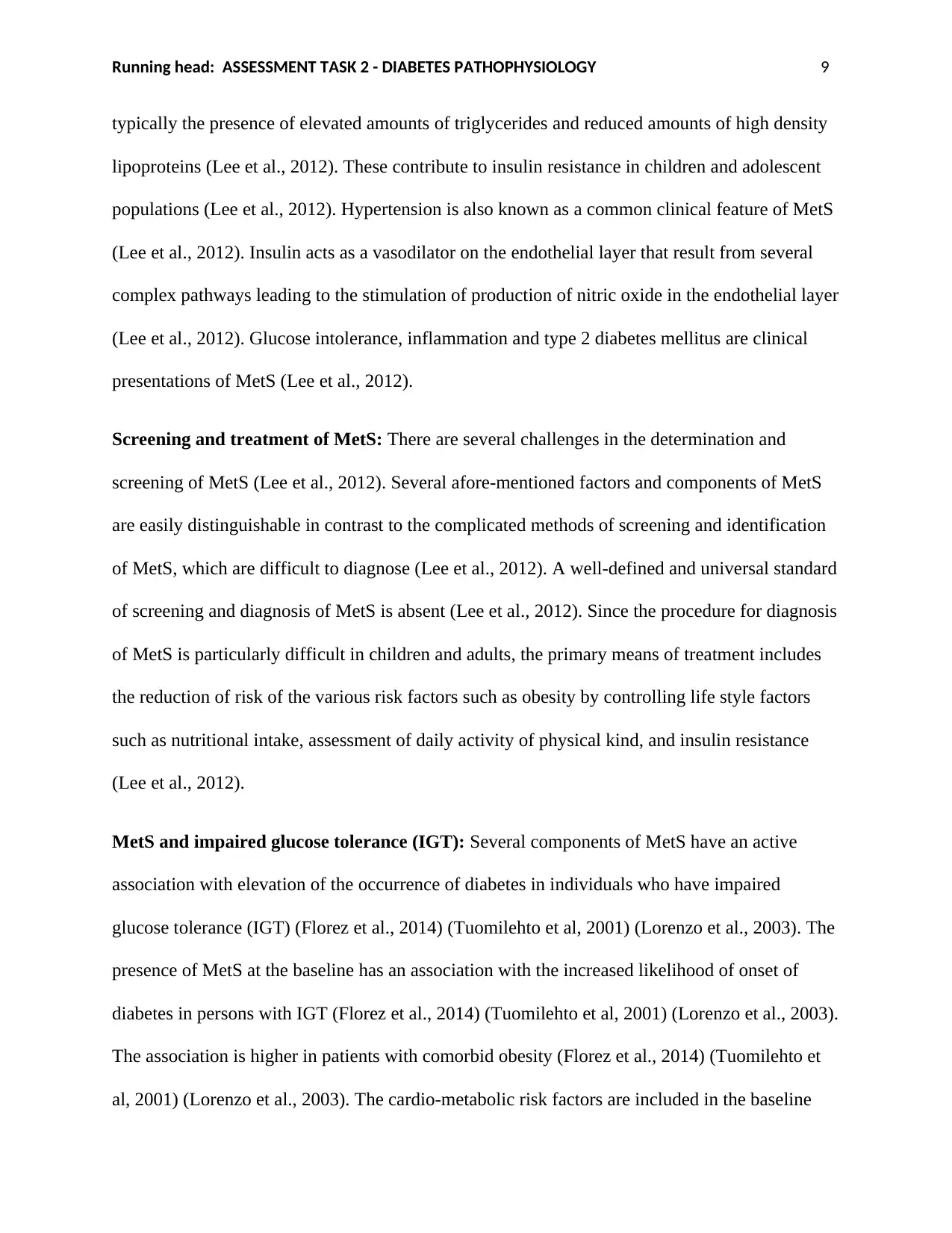
Running head: ASSESSMENT TASK 2 - DIABETES PATHOPHYSIOLOGY 9
typically the presence of elevated amounts of triglycerides and reduced amounts of high density
lipoproteins (Lee et al., 2012). These contribute to insulin resistance in children and adolescent
populations (Lee et al., 2012). Hypertension is also known as a common clinical feature of MetS
(Lee et al., 2012). Insulin acts as a vasodilator on the endothelial layer that result from several
complex pathways leading to the stimulation of production of nitric oxide in the endothelial layer
(Lee et al., 2012). Glucose intolerance, inflammation and type 2 diabetes mellitus are clinical
presentations of MetS (Lee et al., 2012).
Screening and treatment of MetS: There are several challenges in the determination and
screening of MetS (Lee et al., 2012). Several afore-mentioned factors and components of MetS
are easily distinguishable in contrast to the complicated methods of screening and identification
of MetS, which are difficult to diagnose (Lee et al., 2012). A well-defined and universal standard
of screening and diagnosis of MetS is absent (Lee et al., 2012). Since the procedure for diagnosis
of MetS is particularly difficult in children and adults, the primary means of treatment includes
the reduction of risk of the various risk factors such as obesity by controlling life style factors
such as nutritional intake, assessment of daily activity of physical kind, and insulin resistance
(Lee et al., 2012).
MetS and impaired glucose tolerance (IGT): Several components of MetS have an active
association with elevation of the occurrence of diabetes in individuals who have impaired
glucose tolerance (IGT) (Florez et al., 2014) (Tuomilehto et al, 2001) (Lorenzo et al., 2003). The
presence of MetS at the baseline has an association with the increased likelihood of onset of
diabetes in persons with IGT (Florez et al., 2014) (Tuomilehto et al, 2001) (Lorenzo et al., 2003).
The association is higher in patients with comorbid obesity (Florez et al., 2014) (Tuomilehto et
al, 2001) (Lorenzo et al., 2003). The cardio-metabolic risk factors are included in the baseline
typically the presence of elevated amounts of triglycerides and reduced amounts of high density
lipoproteins (Lee et al., 2012). These contribute to insulin resistance in children and adolescent
populations (Lee et al., 2012). Hypertension is also known as a common clinical feature of MetS
(Lee et al., 2012). Insulin acts as a vasodilator on the endothelial layer that result from several
complex pathways leading to the stimulation of production of nitric oxide in the endothelial layer
(Lee et al., 2012). Glucose intolerance, inflammation and type 2 diabetes mellitus are clinical
presentations of MetS (Lee et al., 2012).
Screening and treatment of MetS: There are several challenges in the determination and
screening of MetS (Lee et al., 2012). Several afore-mentioned factors and components of MetS
are easily distinguishable in contrast to the complicated methods of screening and identification
of MetS, which are difficult to diagnose (Lee et al., 2012). A well-defined and universal standard
of screening and diagnosis of MetS is absent (Lee et al., 2012). Since the procedure for diagnosis
of MetS is particularly difficult in children and adults, the primary means of treatment includes
the reduction of risk of the various risk factors such as obesity by controlling life style factors
such as nutritional intake, assessment of daily activity of physical kind, and insulin resistance
(Lee et al., 2012).
MetS and impaired glucose tolerance (IGT): Several components of MetS have an active
association with elevation of the occurrence of diabetes in individuals who have impaired
glucose tolerance (IGT) (Florez et al., 2014) (Tuomilehto et al, 2001) (Lorenzo et al., 2003). The
presence of MetS at the baseline has an association with the increased likelihood of onset of
diabetes in persons with IGT (Florez et al., 2014) (Tuomilehto et al, 2001) (Lorenzo et al., 2003).
The association is higher in patients with comorbid obesity (Florez et al., 2014) (Tuomilehto et
al, 2001) (Lorenzo et al., 2003). The cardio-metabolic risk factors are included in the baseline
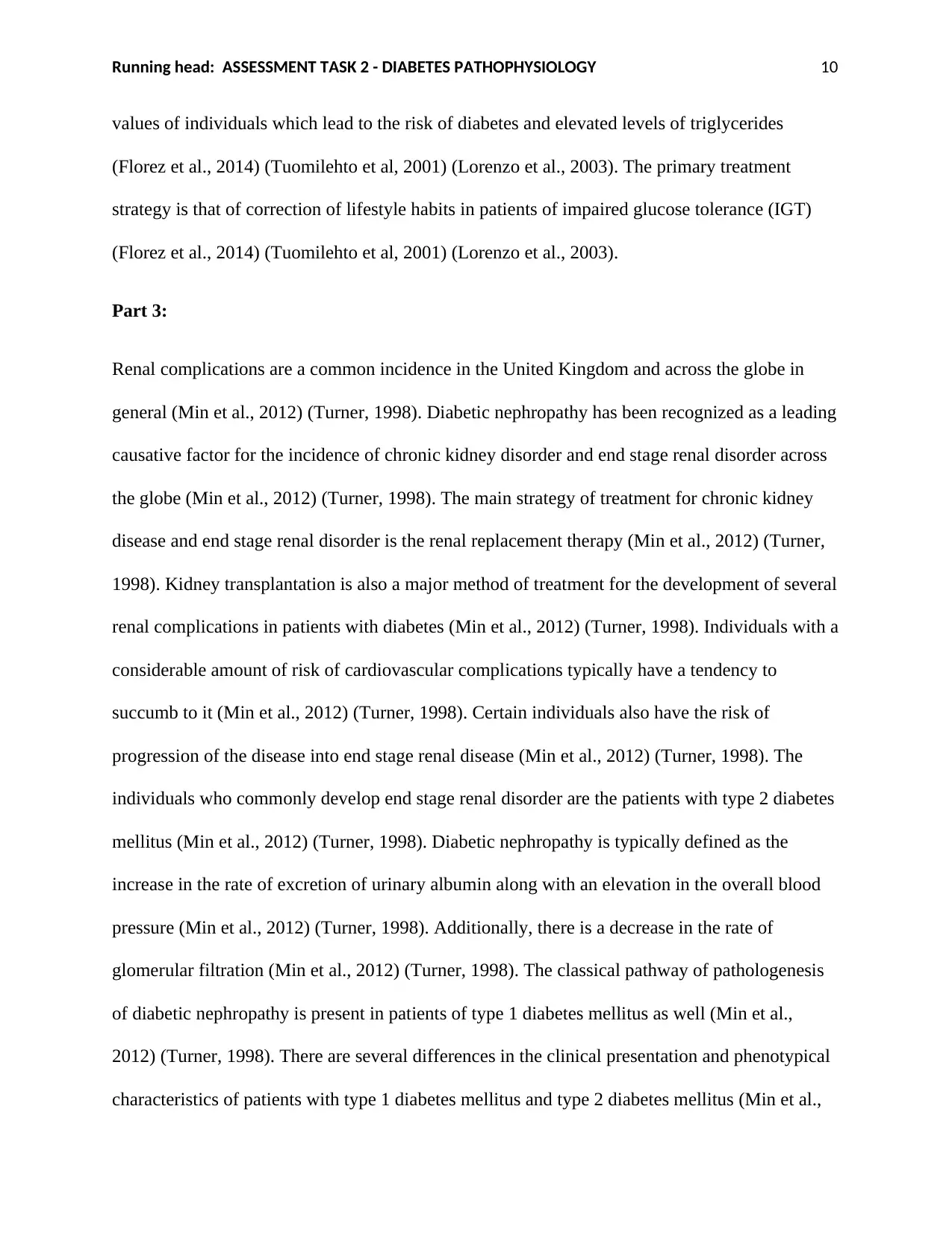
Running head: ASSESSMENT TASK 2 - DIABETES PATHOPHYSIOLOGY 10
values of individuals which lead to the risk of diabetes and elevated levels of triglycerides
(Florez et al., 2014) (Tuomilehto et al, 2001) (Lorenzo et al., 2003). The primary treatment
strategy is that of correction of lifestyle habits in patients of impaired glucose tolerance (IGT)
(Florez et al., 2014) (Tuomilehto et al, 2001) (Lorenzo et al., 2003).
Part 3:
Renal complications are a common incidence in the United Kingdom and across the globe in
general (Min et al., 2012) (Turner, 1998). Diabetic nephropathy has been recognized as a leading
causative factor for the incidence of chronic kidney disorder and end stage renal disorder across
the globe (Min et al., 2012) (Turner, 1998). The main strategy of treatment for chronic kidney
disease and end stage renal disorder is the renal replacement therapy (Min et al., 2012) (Turner,
1998). Kidney transplantation is also a major method of treatment for the development of several
renal complications in patients with diabetes (Min et al., 2012) (Turner, 1998). Individuals with a
considerable amount of risk of cardiovascular complications typically have a tendency to
succumb to it (Min et al., 2012) (Turner, 1998). Certain individuals also have the risk of
progression of the disease into end stage renal disease (Min et al., 2012) (Turner, 1998). The
individuals who commonly develop end stage renal disorder are the patients with type 2 diabetes
mellitus (Min et al., 2012) (Turner, 1998). Diabetic nephropathy is typically defined as the
increase in the rate of excretion of urinary albumin along with an elevation in the overall blood
pressure (Min et al., 2012) (Turner, 1998). Additionally, there is a decrease in the rate of
glomerular filtration (Min et al., 2012) (Turner, 1998). The classical pathway of pathologenesis
of diabetic nephropathy is present in patients of type 1 diabetes mellitus as well (Min et al.,
2012) (Turner, 1998). There are several differences in the clinical presentation and phenotypical
characteristics of patients with type 1 diabetes mellitus and type 2 diabetes mellitus (Min et al.,
values of individuals which lead to the risk of diabetes and elevated levels of triglycerides
(Florez et al., 2014) (Tuomilehto et al, 2001) (Lorenzo et al., 2003). The primary treatment
strategy is that of correction of lifestyle habits in patients of impaired glucose tolerance (IGT)
(Florez et al., 2014) (Tuomilehto et al, 2001) (Lorenzo et al., 2003).
Part 3:
Renal complications are a common incidence in the United Kingdom and across the globe in
general (Min et al., 2012) (Turner, 1998). Diabetic nephropathy has been recognized as a leading
causative factor for the incidence of chronic kidney disorder and end stage renal disorder across
the globe (Min et al., 2012) (Turner, 1998). The main strategy of treatment for chronic kidney
disease and end stage renal disorder is the renal replacement therapy (Min et al., 2012) (Turner,
1998). Kidney transplantation is also a major method of treatment for the development of several
renal complications in patients with diabetes (Min et al., 2012) (Turner, 1998). Individuals with a
considerable amount of risk of cardiovascular complications typically have a tendency to
succumb to it (Min et al., 2012) (Turner, 1998). Certain individuals also have the risk of
progression of the disease into end stage renal disease (Min et al., 2012) (Turner, 1998). The
individuals who commonly develop end stage renal disorder are the patients with type 2 diabetes
mellitus (Min et al., 2012) (Turner, 1998). Diabetic nephropathy is typically defined as the
increase in the rate of excretion of urinary albumin along with an elevation in the overall blood
pressure (Min et al., 2012) (Turner, 1998). Additionally, there is a decrease in the rate of
glomerular filtration (Min et al., 2012) (Turner, 1998). The classical pathway of pathologenesis
of diabetic nephropathy is present in patients of type 1 diabetes mellitus as well (Min et al.,
2012) (Turner, 1998). There are several differences in the clinical presentation and phenotypical
characteristics of patients with type 1 diabetes mellitus and type 2 diabetes mellitus (Min et al.,
Secure Best Marks with AI Grader
Need help grading? Try our AI Grader for instant feedback on your assignments.
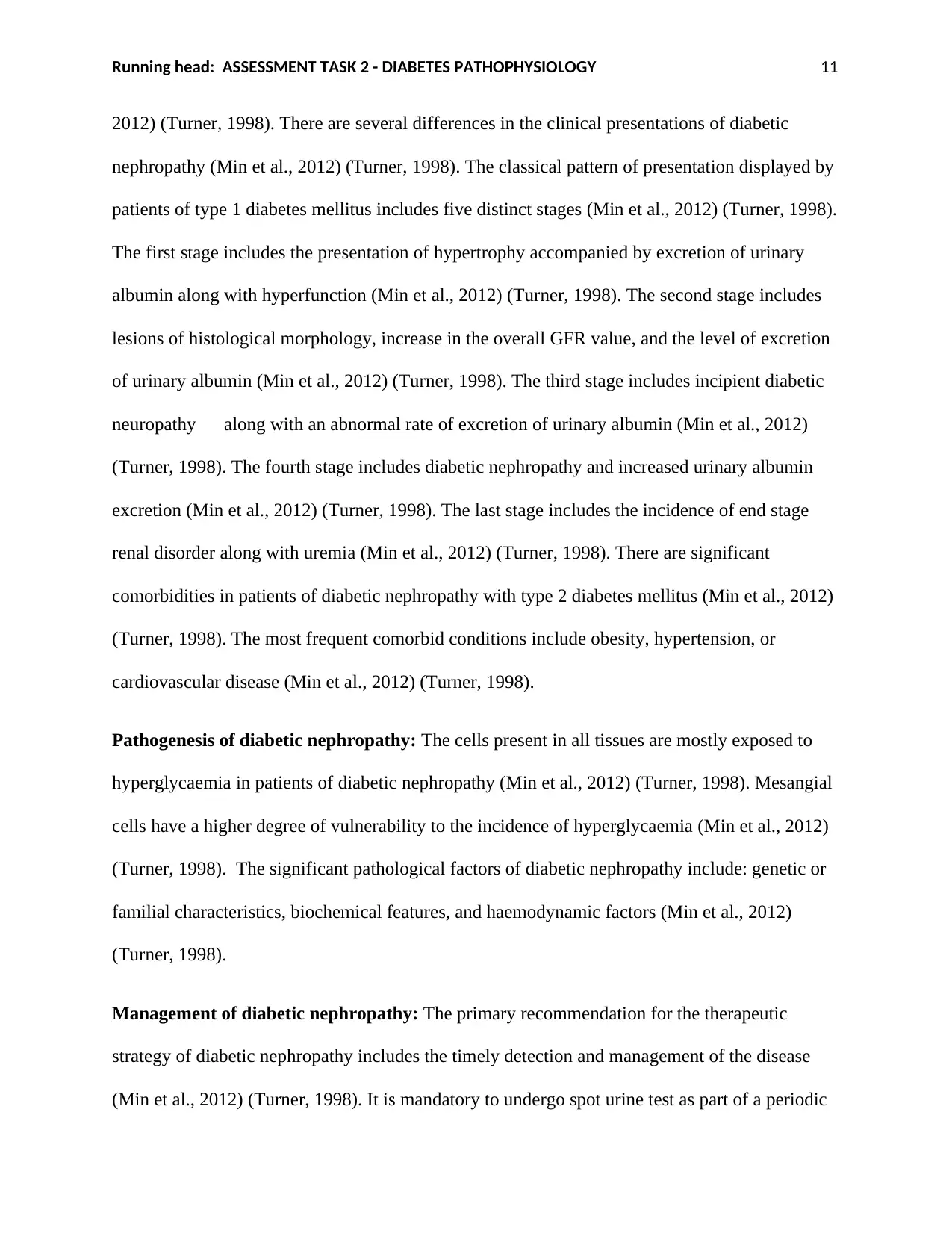
Running head: ASSESSMENT TASK 2 - DIABETES PATHOPHYSIOLOGY 11
2012) (Turner, 1998). There are several differences in the clinical presentations of diabetic
nephropathy (Min et al., 2012) (Turner, 1998). The classical pattern of presentation displayed by
patients of type 1 diabetes mellitus includes five distinct stages (Min et al., 2012) (Turner, 1998).
The first stage includes the presentation of hypertrophy accompanied by excretion of urinary
albumin along with hyperfunction (Min et al., 2012) (Turner, 1998). The second stage includes
lesions of histological morphology, increase in the overall GFR value, and the level of excretion
of urinary albumin (Min et al., 2012) (Turner, 1998). The third stage includes incipient diabetic
neuropathy along with an abnormal rate of excretion of urinary albumin (Min et al., 2012)
(Turner, 1998). The fourth stage includes diabetic nephropathy and increased urinary albumin
excretion (Min et al., 2012) (Turner, 1998). The last stage includes the incidence of end stage
renal disorder along with uremia (Min et al., 2012) (Turner, 1998). There are significant
comorbidities in patients of diabetic nephropathy with type 2 diabetes mellitus (Min et al., 2012)
(Turner, 1998). The most frequent comorbid conditions include obesity, hypertension, or
cardiovascular disease (Min et al., 2012) (Turner, 1998).
Pathogenesis of diabetic nephropathy: The cells present in all tissues are mostly exposed to
hyperglycaemia in patients of diabetic nephropathy (Min et al., 2012) (Turner, 1998). Mesangial
cells have a higher degree of vulnerability to the incidence of hyperglycaemia (Min et al., 2012)
(Turner, 1998). The significant pathological factors of diabetic nephropathy include: genetic or
familial characteristics, biochemical features, and haemodynamic factors (Min et al., 2012)
(Turner, 1998).
Management of diabetic nephropathy: The primary recommendation for the therapeutic
strategy of diabetic nephropathy includes the timely detection and management of the disease
(Min et al., 2012) (Turner, 1998). It is mandatory to undergo spot urine test as part of a periodic
2012) (Turner, 1998). There are several differences in the clinical presentations of diabetic
nephropathy (Min et al., 2012) (Turner, 1998). The classical pattern of presentation displayed by
patients of type 1 diabetes mellitus includes five distinct stages (Min et al., 2012) (Turner, 1998).
The first stage includes the presentation of hypertrophy accompanied by excretion of urinary
albumin along with hyperfunction (Min et al., 2012) (Turner, 1998). The second stage includes
lesions of histological morphology, increase in the overall GFR value, and the level of excretion
of urinary albumin (Min et al., 2012) (Turner, 1998). The third stage includes incipient diabetic
neuropathy along with an abnormal rate of excretion of urinary albumin (Min et al., 2012)
(Turner, 1998). The fourth stage includes diabetic nephropathy and increased urinary albumin
excretion (Min et al., 2012) (Turner, 1998). The last stage includes the incidence of end stage
renal disorder along with uremia (Min et al., 2012) (Turner, 1998). There are significant
comorbidities in patients of diabetic nephropathy with type 2 diabetes mellitus (Min et al., 2012)
(Turner, 1998). The most frequent comorbid conditions include obesity, hypertension, or
cardiovascular disease (Min et al., 2012) (Turner, 1998).
Pathogenesis of diabetic nephropathy: The cells present in all tissues are mostly exposed to
hyperglycaemia in patients of diabetic nephropathy (Min et al., 2012) (Turner, 1998). Mesangial
cells have a higher degree of vulnerability to the incidence of hyperglycaemia (Min et al., 2012)
(Turner, 1998). The significant pathological factors of diabetic nephropathy include: genetic or
familial characteristics, biochemical features, and haemodynamic factors (Min et al., 2012)
(Turner, 1998).
Management of diabetic nephropathy: The primary recommendation for the therapeutic
strategy of diabetic nephropathy includes the timely detection and management of the disease
(Min et al., 2012) (Turner, 1998). It is mandatory to undergo spot urine test as part of a periodic
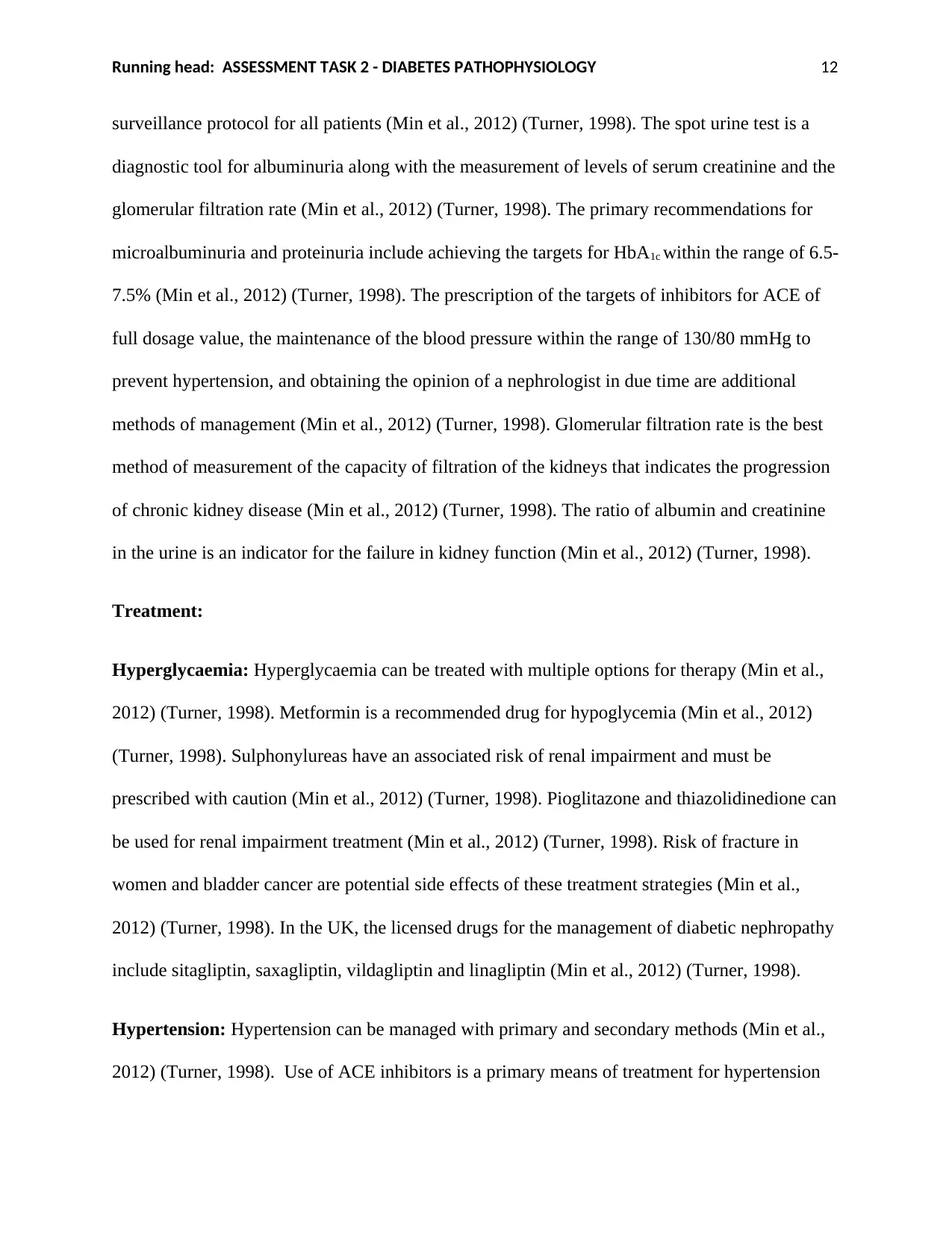
Running head: ASSESSMENT TASK 2 - DIABETES PATHOPHYSIOLOGY 12
surveillance protocol for all patients (Min et al., 2012) (Turner, 1998). The spot urine test is a
diagnostic tool for albuminuria along with the measurement of levels of serum creatinine and the
glomerular filtration rate (Min et al., 2012) (Turner, 1998). The primary recommendations for
microalbuminuria and proteinuria include achieving the targets for HbA1c within the range of 6.5-
7.5% (Min et al., 2012) (Turner, 1998). The prescription of the targets of inhibitors for ACE of
full dosage value, the maintenance of the blood pressure within the range of 130/80 mmHg to
prevent hypertension, and obtaining the opinion of a nephrologist in due time are additional
methods of management (Min et al., 2012) (Turner, 1998). Glomerular filtration rate is the best
method of measurement of the capacity of filtration of the kidneys that indicates the progression
of chronic kidney disease (Min et al., 2012) (Turner, 1998). The ratio of albumin and creatinine
in the urine is an indicator for the failure in kidney function (Min et al., 2012) (Turner, 1998).
Treatment:
Hyperglycaemia: Hyperglycaemia can be treated with multiple options for therapy (Min et al.,
2012) (Turner, 1998). Metformin is a recommended drug for hypoglycemia (Min et al., 2012)
(Turner, 1998). Sulphonylureas have an associated risk of renal impairment and must be
prescribed with caution (Min et al., 2012) (Turner, 1998). Pioglitazone and thiazolidinedione can
be used for renal impairment treatment (Min et al., 2012) (Turner, 1998). Risk of fracture in
women and bladder cancer are potential side effects of these treatment strategies (Min et al.,
2012) (Turner, 1998). In the UK, the licensed drugs for the management of diabetic nephropathy
include sitagliptin, saxagliptin, vildagliptin and linagliptin (Min et al., 2012) (Turner, 1998).
Hypertension: Hypertension can be managed with primary and secondary methods (Min et al.,
2012) (Turner, 1998). Use of ACE inhibitors is a primary means of treatment for hypertension
surveillance protocol for all patients (Min et al., 2012) (Turner, 1998). The spot urine test is a
diagnostic tool for albuminuria along with the measurement of levels of serum creatinine and the
glomerular filtration rate (Min et al., 2012) (Turner, 1998). The primary recommendations for
microalbuminuria and proteinuria include achieving the targets for HbA1c within the range of 6.5-
7.5% (Min et al., 2012) (Turner, 1998). The prescription of the targets of inhibitors for ACE of
full dosage value, the maintenance of the blood pressure within the range of 130/80 mmHg to
prevent hypertension, and obtaining the opinion of a nephrologist in due time are additional
methods of management (Min et al., 2012) (Turner, 1998). Glomerular filtration rate is the best
method of measurement of the capacity of filtration of the kidneys that indicates the progression
of chronic kidney disease (Min et al., 2012) (Turner, 1998). The ratio of albumin and creatinine
in the urine is an indicator for the failure in kidney function (Min et al., 2012) (Turner, 1998).
Treatment:
Hyperglycaemia: Hyperglycaemia can be treated with multiple options for therapy (Min et al.,
2012) (Turner, 1998). Metformin is a recommended drug for hypoglycemia (Min et al., 2012)
(Turner, 1998). Sulphonylureas have an associated risk of renal impairment and must be
prescribed with caution (Min et al., 2012) (Turner, 1998). Pioglitazone and thiazolidinedione can
be used for renal impairment treatment (Min et al., 2012) (Turner, 1998). Risk of fracture in
women and bladder cancer are potential side effects of these treatment strategies (Min et al.,
2012) (Turner, 1998). In the UK, the licensed drugs for the management of diabetic nephropathy
include sitagliptin, saxagliptin, vildagliptin and linagliptin (Min et al., 2012) (Turner, 1998).
Hypertension: Hypertension can be managed with primary and secondary methods (Min et al.,
2012) (Turner, 1998). Use of ACE inhibitors is a primary means of treatment for hypertension
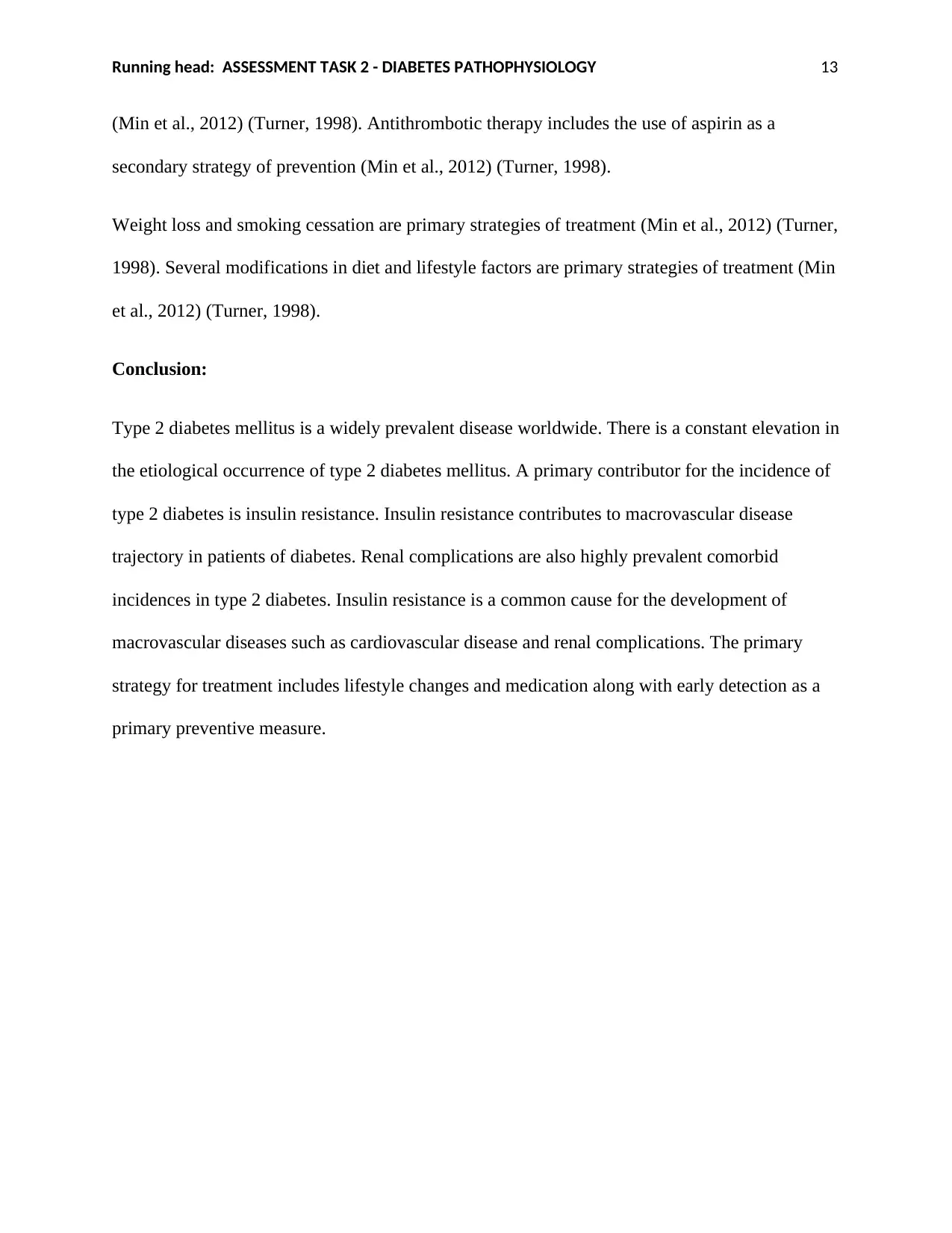
Running head: ASSESSMENT TASK 2 - DIABETES PATHOPHYSIOLOGY 13
(Min et al., 2012) (Turner, 1998). Antithrombotic therapy includes the use of aspirin as a
secondary strategy of prevention (Min et al., 2012) (Turner, 1998).
Weight loss and smoking cessation are primary strategies of treatment (Min et al., 2012) (Turner,
1998). Several modifications in diet and lifestyle factors are primary strategies of treatment (Min
et al., 2012) (Turner, 1998).
Conclusion:
Type 2 diabetes mellitus is a widely prevalent disease worldwide. There is a constant elevation in
the etiological occurrence of type 2 diabetes mellitus. A primary contributor for the incidence of
type 2 diabetes is insulin resistance. Insulin resistance contributes to macrovascular disease
trajectory in patients of diabetes. Renal complications are also highly prevalent comorbid
incidences in type 2 diabetes. Insulin resistance is a common cause for the development of
macrovascular diseases such as cardiovascular disease and renal complications. The primary
strategy for treatment includes lifestyle changes and medication along with early detection as a
primary preventive measure.
(Min et al., 2012) (Turner, 1998). Antithrombotic therapy includes the use of aspirin as a
secondary strategy of prevention (Min et al., 2012) (Turner, 1998).
Weight loss and smoking cessation are primary strategies of treatment (Min et al., 2012) (Turner,
1998). Several modifications in diet and lifestyle factors are primary strategies of treatment (Min
et al., 2012) (Turner, 1998).
Conclusion:
Type 2 diabetes mellitus is a widely prevalent disease worldwide. There is a constant elevation in
the etiological occurrence of type 2 diabetes mellitus. A primary contributor for the incidence of
type 2 diabetes is insulin resistance. Insulin resistance contributes to macrovascular disease
trajectory in patients of diabetes. Renal complications are also highly prevalent comorbid
incidences in type 2 diabetes. Insulin resistance is a common cause for the development of
macrovascular diseases such as cardiovascular disease and renal complications. The primary
strategy for treatment includes lifestyle changes and medication along with early detection as a
primary preventive measure.
Paraphrase This Document
Need a fresh take? Get an instant paraphrase of this document with our AI Paraphraser
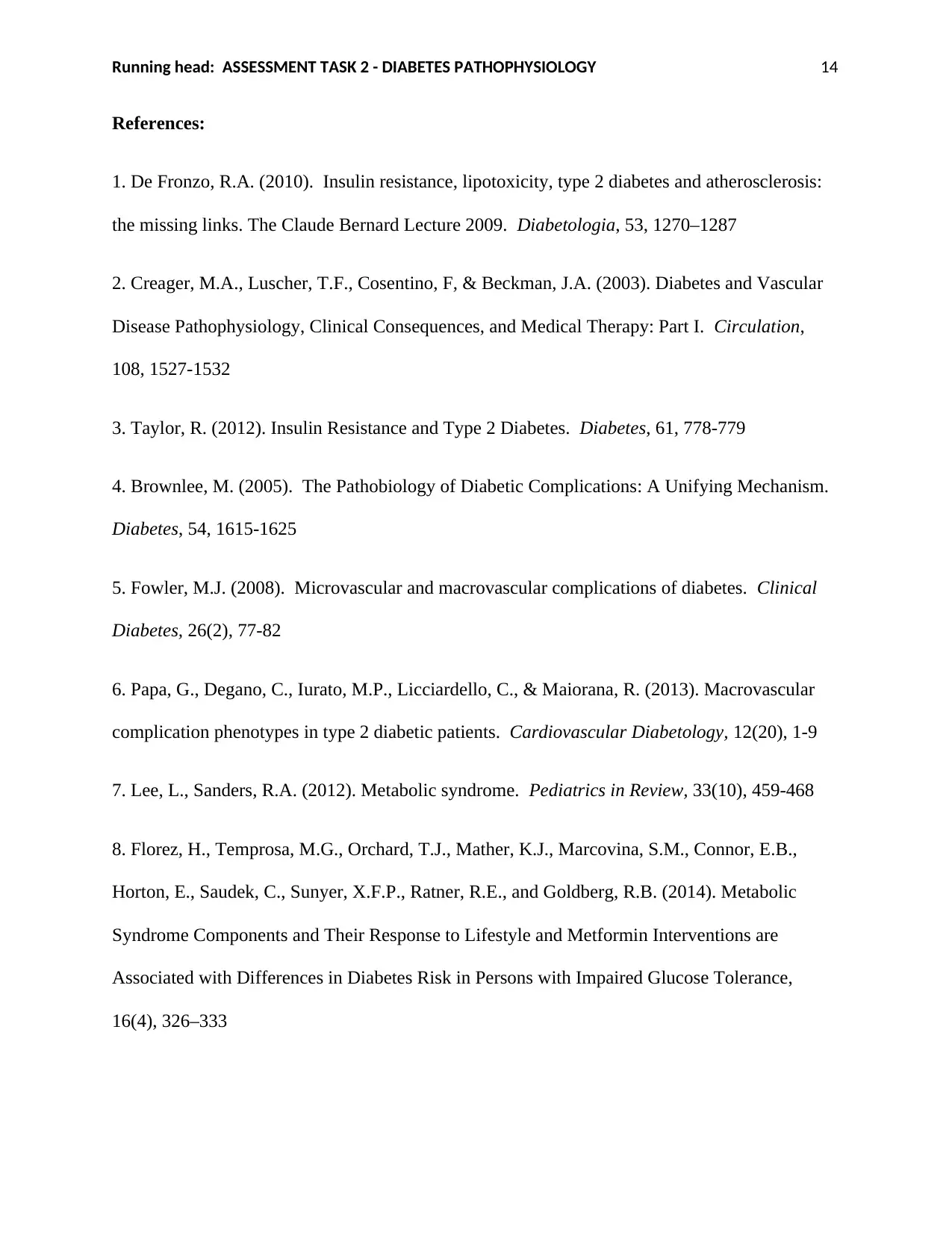
Running head: ASSESSMENT TASK 2 - DIABETES PATHOPHYSIOLOGY 14
References:
1. De Fronzo, R.A. (2010). Insulin resistance, lipotoxicity, type 2 diabetes and atherosclerosis:
the missing links. The Claude Bernard Lecture 2009. Diabetologia, 53, 1270–1287
2. Creager, M.A., Luscher, T.F., Cosentino, F, & Beckman, J.A. (2003). Diabetes and Vascular
Disease Pathophysiology, Clinical Consequences, and Medical Therapy: Part I. Circulation,
108, 1527-1532
3. Taylor, R. (2012). Insulin Resistance and Type 2 Diabetes. Diabetes, 61, 778-779
4. Brownlee, M. (2005). The Pathobiology of Diabetic Complications: A Unifying Mechanism.
Diabetes, 54, 1615-1625
5. Fowler, M.J. (2008). Microvascular and macrovascular complications of diabetes. Clinical
Diabetes, 26(2), 77-82
6. Papa, G., Degano, C., Iurato, M.P., Licciardello, C., & Maiorana, R. (2013). Macrovascular
complication phenotypes in type 2 diabetic patients. Cardiovascular Diabetology, 12(20), 1-9
7. Lee, L., Sanders, R.A. (2012). Metabolic syndrome. Pediatrics in Review, 33(10), 459-468
8. Florez, H., Temprosa, M.G., Orchard, T.J., Mather, K.J., Marcovina, S.M., Connor, E.B.,
Horton, E., Saudek, C., Sunyer, X.F.P., Ratner, R.E., and Goldberg, R.B. (2014). Metabolic
Syndrome Components and Their Response to Lifestyle and Metformin Interventions are
Associated with Differences in Diabetes Risk in Persons with Impaired Glucose Tolerance,
16(4), 326–333
References:
1. De Fronzo, R.A. (2010). Insulin resistance, lipotoxicity, type 2 diabetes and atherosclerosis:
the missing links. The Claude Bernard Lecture 2009. Diabetologia, 53, 1270–1287
2. Creager, M.A., Luscher, T.F., Cosentino, F, & Beckman, J.A. (2003). Diabetes and Vascular
Disease Pathophysiology, Clinical Consequences, and Medical Therapy: Part I. Circulation,
108, 1527-1532
3. Taylor, R. (2012). Insulin Resistance and Type 2 Diabetes. Diabetes, 61, 778-779
4. Brownlee, M. (2005). The Pathobiology of Diabetic Complications: A Unifying Mechanism.
Diabetes, 54, 1615-1625
5. Fowler, M.J. (2008). Microvascular and macrovascular complications of diabetes. Clinical
Diabetes, 26(2), 77-82
6. Papa, G., Degano, C., Iurato, M.P., Licciardello, C., & Maiorana, R. (2013). Macrovascular
complication phenotypes in type 2 diabetic patients. Cardiovascular Diabetology, 12(20), 1-9
7. Lee, L., Sanders, R.A. (2012). Metabolic syndrome. Pediatrics in Review, 33(10), 459-468
8. Florez, H., Temprosa, M.G., Orchard, T.J., Mather, K.J., Marcovina, S.M., Connor, E.B.,
Horton, E., Saudek, C., Sunyer, X.F.P., Ratner, R.E., and Goldberg, R.B. (2014). Metabolic
Syndrome Components and Their Response to Lifestyle and Metformin Interventions are
Associated with Differences in Diabetes Risk in Persons with Impaired Glucose Tolerance,
16(4), 326–333
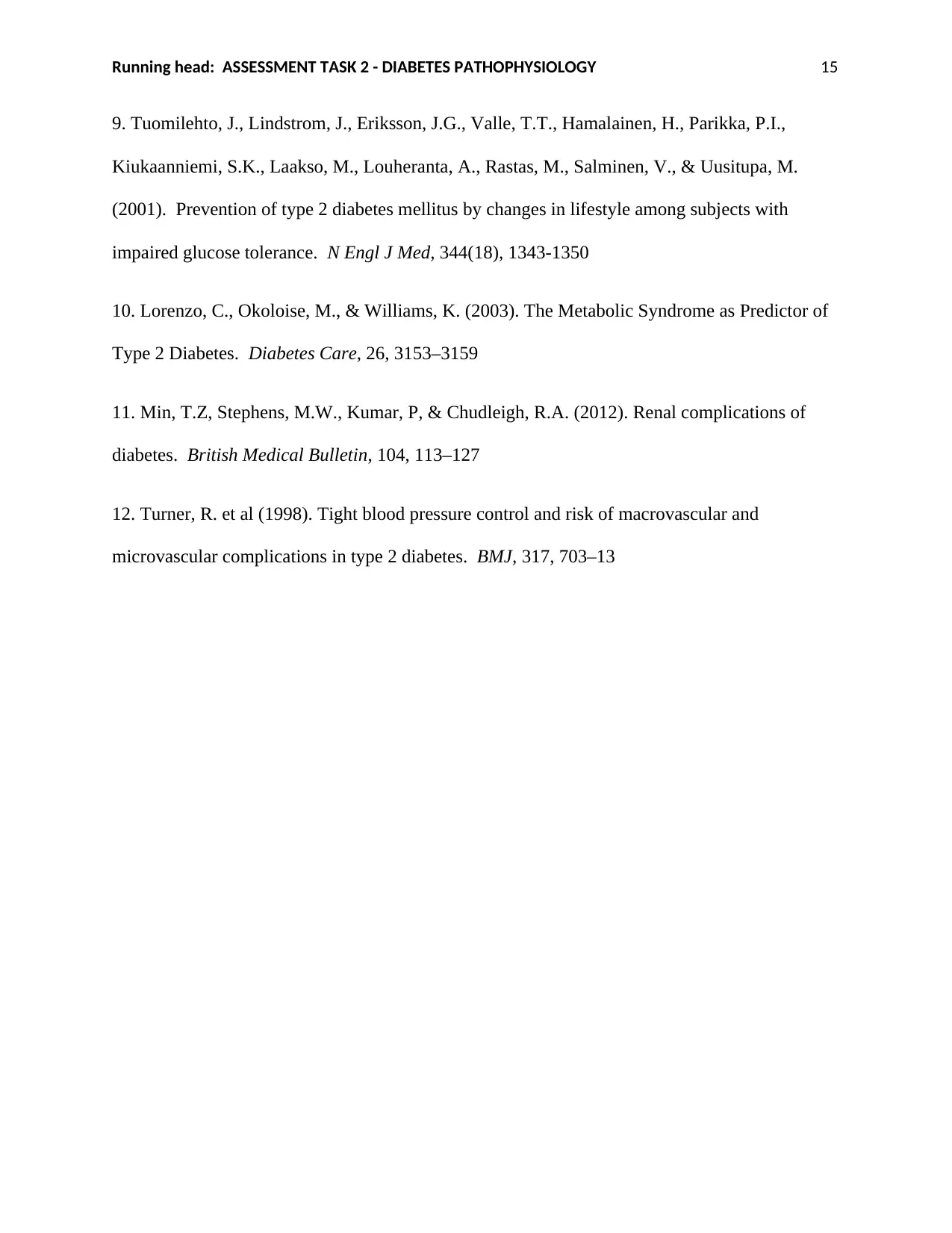
Running head: ASSESSMENT TASK 2 - DIABETES PATHOPHYSIOLOGY 15
9. Tuomilehto, J., Lindstrom, J., Eriksson, J.G., Valle, T.T., Hamalainen, H., Parikka, P.I.,
Kiukaanniemi, S.K., Laakso, M., Louheranta, A., Rastas, M., Salminen, V., & Uusitupa, M.
(2001). Prevention of type 2 diabetes mellitus by changes in lifestyle among subjects with
impaired glucose tolerance. N Engl J Med, 344(18), 1343-1350
10. Lorenzo, C., Okoloise, M., & Williams, K. (2003). The Metabolic Syndrome as Predictor of
Type 2 Diabetes. Diabetes Care, 26, 3153–3159
11. Min, T.Z, Stephens, M.W., Kumar, P, & Chudleigh, R.A. (2012). Renal complications of
diabetes. British Medical Bulletin, 104, 113–127
12. Turner, R. et al (1998). Tight blood pressure control and risk of macrovascular and
microvascular complications in type 2 diabetes. BMJ, 317, 703–13
9. Tuomilehto, J., Lindstrom, J., Eriksson, J.G., Valle, T.T., Hamalainen, H., Parikka, P.I.,
Kiukaanniemi, S.K., Laakso, M., Louheranta, A., Rastas, M., Salminen, V., & Uusitupa, M.
(2001). Prevention of type 2 diabetes mellitus by changes in lifestyle among subjects with
impaired glucose tolerance. N Engl J Med, 344(18), 1343-1350
10. Lorenzo, C., Okoloise, M., & Williams, K. (2003). The Metabolic Syndrome as Predictor of
Type 2 Diabetes. Diabetes Care, 26, 3153–3159
11. Min, T.Z, Stephens, M.W., Kumar, P, & Chudleigh, R.A. (2012). Renal complications of
diabetes. British Medical Bulletin, 104, 113–127
12. Turner, R. et al (1998). Tight blood pressure control and risk of macrovascular and
microvascular complications in type 2 diabetes. BMJ, 317, 703–13
1 out of 15
Related Documents
Your All-in-One AI-Powered Toolkit for Academic Success.
+13062052269
info@desklib.com
Available 24*7 on WhatsApp / Email
![[object Object]](/_next/static/media/star-bottom.7253800d.svg)
Unlock your academic potential
© 2024 | Zucol Services PVT LTD | All rights reserved.





